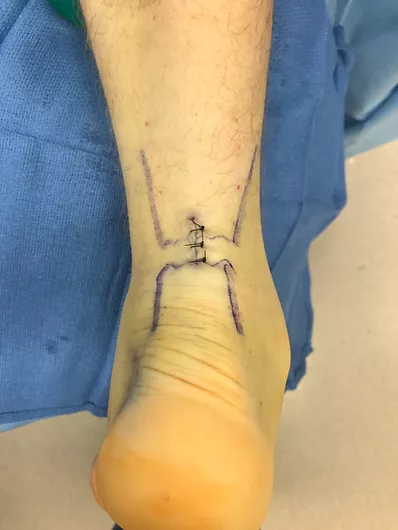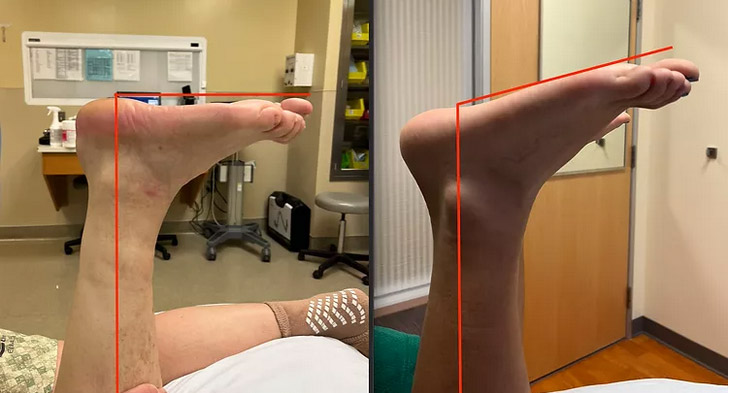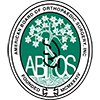What is the Achilles tendon?
The Achilles tendon is the large tendon that connects your calf muscles to the back of your heel bone. It is a powerful tendon that is responsible for allowing you to push-off of your foot.
What is an Achilles tendon rupture?
The Achilles tendon can, unfortunately, tear or rupture. It generally ruptures a few centimeters above where it inserts onto the back of your heel bone. With an Achilles tendon rupture, the powerful calf muscles no longer are connected to your heel bone and you can have difficulty pushing-off with your foot.
How do I know if I had an Achilles tendon rupture?
Most patients have their Achilles tendon rupture while playing sports or engaging in an activity during which they forcefully push off of their foot.
Patients often report hearing a loud “pop” and feeling as if they were struck at the back of their calf or ankle.
Patients often describe thinking that a teammate or opponent kicked them at their calf, but no one else being around them.
Patients often have pain and swelling at the back of their calf/ankle.
There are also some tell-tale signs of an Achilles rupture:
- Normally, the toes should point slightly up toward the ceiling if you are lying down on your stomach and have your knee bent (to a 90 degree angle) (see the right panel of the picture below).
With an Achilles tendon rupture, the toes will be flat and will not point slightly up towards the ceiling (see left panel fo the picture below). Left panel: example of a rupture Achilles. Note how the bottom of the foot/toes are flat.
Right panel: example of a normal Achilles tendon. Note how the bottom of the foot/toes point slightly towards the ceiling.
Left panel: example of a rupture Achilles. Note how the bottom of the foot/toes are flat.
Right panel: example of a normal Achilles tendon. Note how the bottom of the foot/toes point slightly towards the ceiling.
- With an Achilles tendon rupture, one can often see and feel a gap across the tendon
- Normally, your ankle/toes will flicker or flex up towards the ceiling (when you are lying down on your stomach and have your knee bent up). With an Achilles tendon rupture, your ankle/toes will not flicker up (or the movement will be greatly diminished).
Achilles Tendon Rupture | Thompson Test | Dr. Anthony Yi, MD | Seattle, WA
Do I need imaging to confirm that I have an Achilles tendon rupture?
Most of the time, an Achilles rupture can be diagnosed based on a conversation and examining the ankle.
However, it is important to note that imaging (such as an x-ray) can be necessary to make sure there are no other additional injuries.
An ultrasound or MRI is usually not necessary to diagnosis an Achilles tendon rupture.
However, imaging (such as an ultrasound or MRI) could be useful if the diagnosis is in question.
What should I do if I think I had an Achilles tendon rupture?
Avoid putting down weight on your injured leg (crutches and knee scooters are popular option) and seek medical attention (from an orthopedic surgeon that specifically has expertise in treating Achilles tendon ruptures).
While an Achilles tendon rupture is not an emergency, it is an urgent issue and you should start treatment as soon as possible (whether you ultimately choose surgery or non-surgical treatment).
Unfortunately, Achilles tendon ruptures can be missed and an untreated patient generally has very poor outcomes/function. Furthermore, a chronic (old) and untreated Achilles tendon rupture is a much more difficult condition to treat compared to an acute (fresh or new) Achilles tendon rupture.
It is important to note that non-surgical treatment is not the same as no treatment. There are specific, vital treatments involved in non-surgical care for Achilles tendon ruptures.
Should I have surgery for my Achilles tendon rupture?
Both surgical and non-surgical treatment of Achilles tendon ruptures are reasonable options.
Patients that ultimately choose to have surgery often choose surgery because of the following benefits: greater calf strength, greater calf endurance, and a lower chance of re-rupture.
However, the most appropriate treatment option depends on many factors including who you are, your goals, your life situation, your other medical issues, and much more.
Dr. Anthony Yi would be happy to talk with you about your options.
What is minimally invasive Achilles tendon rupture repair?
Minimally invasive Achilles tendon repair is a method of repairing Achilles tendon ruptures through small incisions (roughly ~3 cm in length).
Traditional Achilles tendon repair involves a long incision that is more than 2-3 times the length of minimally invasive surgery.
The benefits of minimally invasive surgery are: less wound healing complications, less infection complications, smaller incision, and no change in success rate compared to traditional Achilles tendon repair.
Dr. Anthony Yi is trained in minimally invasive Achilles tendon repair, which research has shown to be effective, safe, and durable.
 Example of the small incision through which Dr. Anthony Yi repairs Achilles tendon through his minimally invasive surgical technique.
Example of the small incision through which Dr. Anthony Yi repairs Achilles tendon through his minimally invasive surgical technique.
When can I get back to activity after an Achilles tendon rupture?
The timeline for recovery is similar for both surgical and non-surgical treatment.
Click here for Dr. Anthony Yi’s postoperative surgical protocol for Achilles tendon ruptures.
Generally, it takes about 6 months before patients are getting back into sporting activities reasonably well. However, professional athletes can often take up to 1 year to get back to their level of play.









